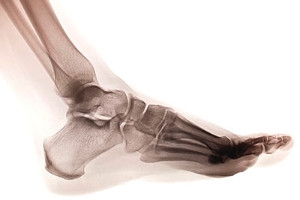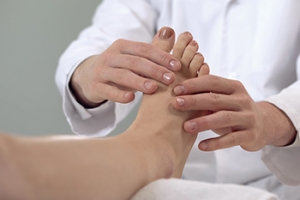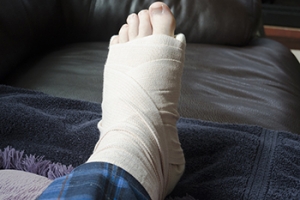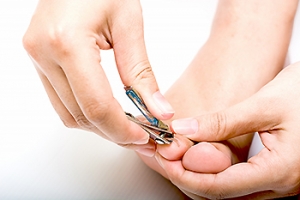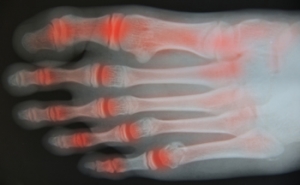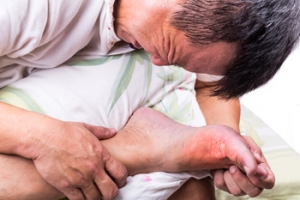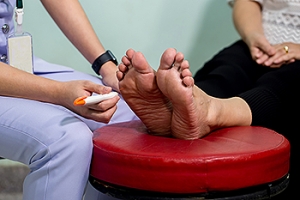Connect With Us
Featured Articles
Super User
What Is a Metatarsal Stress Fracture?
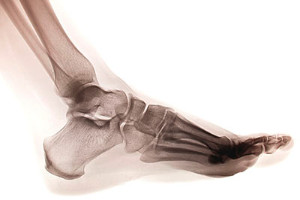
There are five metatarsal bones found in the foot, each connecting the heel/arch to the toes. These long bones play a critical role in helping the foot function. However, the metatarsal bones can suffer from what is known as a stress fracture, a crack in the bone that develops from repeated trauma. The metatarsal bones are the second most common bones in the lower limbs to suffer from stress fractures, the first being the tibia leg bone. Of the five metatarsals, the second and third metatarsal bones are the most commonly afflicted. One common symptom of a metatarsal stress fracture is pain felt in the foot when walking or running. If you are running long distances and are not wearing the right kind of footwear, you might be increasing your risk of developing a stress fracture. Contact a podiatrist today for more information about metatarsal stress fractures.
Activities where too much pressure is put on the feet can cause stress fractures. To learn more, contact Scott Matthews, DPM, MD from Salem Foot Care . Our doctor can provide the care you need to keep your pain free and on your feet.
Dealing with Stress Fractures of the Foot and Ankle
Stress fractures occur in the foot and ankle when muscles in these areas weaken from too much or too little use. The feet and ankles then lose support when walking or running from the impact of the ground. Since there is no protection, the bones receive the full impact of each step. Stress on the feet can cause cracks to form in the bones, thus creating stress fractures.
What Are Stress Fractures?
Stress fractures occur frequently in individuals whose daily activities cause great impact on the feet and ankles. Stress factors are most common among:
- Runners
- People affected with Osteoporosis
- Tennis or basketball players
- Gymnasts
- High impact workouts
Symptoms
Pain from the fractures occur in the area of the fractures and can be constant or intermittent. It will often cause sharp or dull pain with swelling and tenderness. Engaging in any kind of activity which involves high impact will aggravate pain.
If you have any questions please feel free to contact our office located in Wikesboro, NC . We offer the newest diagnostic and treatment technologies for all your foot and ankle needs.
Dealing With Corns on the Feet
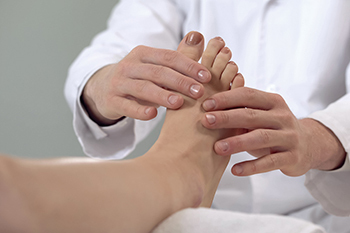
Corns on the foot develop from friction, usually as a result of a toe rubbing against the inside of a shoe. A callus, or toughened skin, develops with a hardened kernel at its center, thus the name corn. Most corns can be treated with a series of foot care measures, but people with diabetes, poor circulation, or foot deformities are wise to seek immediate help from a podiatrist. The first and best defense against developing a corn is to wear shoes that fit properly and to wear socks that form a kind of cushion, lessening friction. A warm foot bath can help soften the callused area, and a pumice can help to reduce its size. Keeping the feet moisturized also can help prevent the formation of a corn. A number of types of foot pads are available to protect the toe from further friction. It is not wise to try to remove a corn yourself with any sharp object, as this may lead to an infection. If a corn does not go away or causes severe pain, it is a good idea to make an appointment with a podiatrist who can treat the problem safely.
If you have any concerns regarding your feet and ankles, contact Scott Matthews, DPM, MD of Salem Foot Care . Our doctor will treat your foot and ankle needs.
Corns: What Are They? and How Do You Get Rid of Them?
Corns can be described as areas of the skin that have thickened to the point of becoming painful or irritating. They are often layers and layers of the skin that have become dry and rough, and are normally smaller than calluses.
Ways to Prevent Corns
There are many ways to get rid of painful corns such as wearing:
- Well-fitting socks
- Comfortable shoes that are not tight around your foot
- Shoes that offer support
Treating Corns
Treatment of corns involves removing the dead skin that has built up in the specific area of the foot. Consult with Our doctor to determine the best treatment option for your case of corns.
If you have any questions please feel free to contact our office located in Wikesboro, NC . We offer the newest diagnostic and treatment technologies for all your foot and ankle needs.
Types of Foot Fractures

One of the most detrimental conditions to negatively impact the health of the feet is broken or fractured feet. An individual has a fracture of their feet when a bone breaks. If you have a fractured foot, you may experience pain in and around the feet. Your affected foot might even appear bruised, and it could be difficult for you to put weight on it. Generally speaking, there are two main types of broken feet. First, you can develop what is known as a full foot fracture. This condition is caused by some type of one-time injury. Commonly, individuals can develop a full foot fracture by dropping a significantly heavy object directly onto their foot. If you have a full foot injury, the various muscles and tissues that surround the foot might be injured or affected. However, this is not always the case with certain full foot injuries. Second, you can develop what is known as a stress fracture in the foot. This type of injury occurs over an extended period of time when a specific part of the foot undergoes repeated stress and overuse. These two types of foot fractures have different causes, yet they can share some of the same symptoms. If you believe that you may have broken or fractured your foot, you can seek guidance from a podiatrist who can help you identify and address the problem.
A broken foot requires immediate medical attention and treatment. If you need your feet checked, contact Scott Matthews, DPM, MD from Salem Foot Care . Our doctor can provide the care you need to keep you pain-free and on your feet.
Broken Foot Causes, Symptoms, and Treatment
A broken foot is caused by one of the bones in the foot typically breaking when bended, crushed, or stretched beyond its natural capabilities. Usually the location of the fracture indicates how the break occurred, whether it was through an object, fall, or any other type of injury.
Common Symptoms of Broken Feet:
- Bruising
- Pain
- Redness
- Swelling
- Blue in color
- Numbness
- Cold
- Misshapen
- Cuts
- Deformities
Those that suspect they have a broken foot shoot seek urgent medical attention where a medical professional could diagnose the severity.
Treatment for broken bones varies depending on the cause, severity and location. Some will require the use of splints, casts or crutches while others could even involve surgery to repair the broken bones. Personal care includes the use of ice and keeping the foot stabilized and elevated.
If you have any questions please feel free to contact our office located in Wikesboro, NC . We offer the newest diagnostic and treatment technologies for all your foot and ankle needs.
Proper Tools for Cutting Toenails
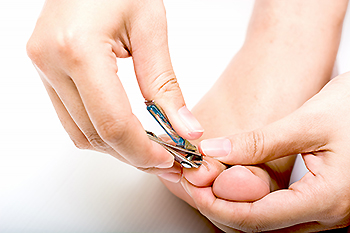
Cutting one’s toenails is a key component of maintaining healthy feet. Not only does keeping your toenails cut to an appropriate length help stave off the development of ingrown toenails, it is also a way to make your feet look more visually appealing. However, many individuals who attempt to cut their toenails fail to utilize the appropriate tools for this critical self-care practice. For example, many individuals attempt to cut their toenails by using a pair of regular scissors or even a cutting knife. These tools are not appropriate and can be very dangerous. Instead, you may opt for a proper pair of toenail clippers. It is important that you utilize a different, larger pair of nail clippers used exclusively for your toenails. This is because using the same pair of nail clippers on both your fingernails and your toenails can spread bacteria and be unhealthy. In addition to having two pairs of different nail clippers, you should also be mindful of keeping them clean. You can clean and disinfect your pair of toenail clippers after each use to make sure that you are doing your best to prevent the spread of harmful bacteria. Lastly, another proper tool for cutting your toenails is a nail file, such as an emery board. You can use this tool to smooth the edges of your nails after clipping them. For more information on the proper tools you should be using to cut your toenails, consult a podiatrist.
Everyday foot care is very important to prevent infection and other foot ailments. If you need your feet checked, contact Scott Matthews, DPM, MD from Salem Foot Care . Our doctor can provide the care you need to keep you pain-free and on your feet.
Everyday Foot Care
Often, people take care of their bodies, face and hair more so than they do for their feet. But the feet are a very important aspect of our bodies, and one that we should pay more attention to. Without our feet, we would not be able to perform most daily tasks.
It is best to check your feet regularly to make sure there are no new bruises or cuts that you may not have noticed before. For dry feet, moisturizer can easily be a remedy and can be applied as often as necessary to the affected areas. Wearing shoes that fit well can also help you maintain good foot health, as well as making it easier to walk and do daily activities without the stress or pain of ill-fitting shoes, high heels, or even flip flops. Wearing clean socks with closed shoes is important to ensure that sweat and bacteria do not accumulate within the shoe. Clean socks help to prevent Athlete’s foot, fungi problems, bad odors, and can absorb sweat.
If you have any questions please feel free to contact our office located in Wikesboro, NC . We offer the newest diagnostic and treatment technologies for all your foot and ankle needs.
How Rheumatoid Arthritis Affects the Feet
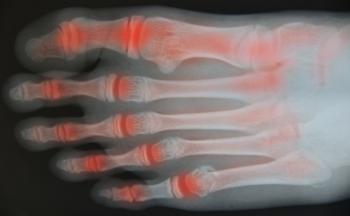
Experts say that 90 percent of people with rheumatoid arthritis (RA) will experience problems with their feet and ankles. Inflammation from this disease causes pain, swelling, redness and a limited range of movement in the joints. In addition, the cartilage, ligaments, and tendons are broken down by the immune system. This, in turn, may cause difficulty in standing and walking for long periods of time. Rheumatoid arthritis can affect the ankle by making it more difficult to go up and down steps. In the hindfoot area, RA impedes the ability to walk on uneven surfaces, such as gravel. Pain generally starts on the outside of the foot, and eventually moves to the arch and the inside of the foot. It may even lead to flat feet as bones shift and become damaged. In the midfoot, the ligaments that support the feet become weaker and cause a collapse of the arch. Deformities in the toes, such as bunions and hammertoe, caused by rheumatoid arthritis may make it difficult not only to walk, but to wear shoes. If you have rheumatoid arthritis, it is a good idea to develop an ongoing relationship with a podiatrist to monitor these and other changes to your feet and ankles.
Because RA affects more than just your joints, including the joints in your feet and ankles, it is important to seek early diagnosis from your podiatrist if you feel like the pain in your feet might be caused by RA. For more information, contact Scott Matthews, DPM, MD of Salem Foot Care . Our doctor will assist you with all of your podiatric concerns.
What Is Rheumatoid Arthritis?
Rheumatoid Arthritis (RA) is an autoimmune disorder in which the body’s own immune system attacks the membranes surrounding the joints. Inflammation of the lining and eventually the destruction of the joint’s cartilage and bone occur, causing severe pain and immobility.
Rheumatoid Arthritis of the Feet
Although RA usually attacks multiple bones and joints throughout the entire body, almost 90 percent of cases result in pain in the foot or ankle area.
Symptoms
- Swelling and pain in the feet
- Stiffness in the feet
- Pain on the ball or sole of feet
- Joint shift and deformation
Diagnosis
Quick diagnosis of RA in the feet is important so that the podiatrist can treat the area effectively. Your doctor will ask you about your medical history, occupation, and lifestyle to determine the origin of the condition. Rheumatoid Factor tests help to determine if someone is affected by the disease.
If you have any questions please feel free to contact our office located in Wikesboro, NC . We offer the newest diagnostic and treatment technologies for all your foot and ankle needs.
Rheumatoid Arthritis in the Feet
Rheumatoid Arthritis is a chronic progressive disease that attacks several joints throughout the body. It is an autoimmune disease in which the body’s immune system mistakenly attacks the joints. As a result, the tissue inside the joints, called synovium, starts to thicken and causes pain around the joints. The synovium is responsible for creating a fluid that lubricates the joints to help them move. Approximately 1.5 million people in the United States have Rheumatoid Arthritis. Women are almost three times as likely to have RA compared to men, and it’s disease usually begins between the ages of 30 and 60. People who have a genetic history of RA are more likely to develop the disease.
Symptoms of RA may include the following sensations in the joints: pain, tenderness, swelling, redness, warmth, stiffness, and loss of range. Swollen joints are a very common symptom for those with the disease. At times, it may be minimal, but it may also be very apparent. Another typical symptom is joint stiffness. Doctors will often use the direction of morning stiffness to measure the severity of a patient’s joint inflammation. Other RA symptoms include limping, anemia, fever, and fatigue.
To diagnose RA, your podiatrist will typically request x-rays to see how much damage there is in the joints. Blood tests may also be performed to show if there are any signs of anemia, or antibodies such as the rheumatoid factor. If you have previously been diagnosed with RA, you should know the disease may spread to your feet and ankles.
There are many non-surgical options that can be used to treat this ailment. Some of these options include physical therapy, foot massages, orthotics, bracing, supportive shoes, and steroid injections. Physical therapy is useful because it will help stretch and strengthen the joints in both the foot and ankle to improve joint function. Massages can help improve blood circulation which will be good for the feet. Choosing proper footwear will allow you to walk with comfortability if you are a sufferer from RA. Lastly, bracing will help stabilize the foot joints, limit deformities and decrease pain.
In severe cases, surgery may be a treatment option that should be considered. For those who cannot walk without experiencing pain and those whose deformities can not be managed with braces, surgery should be considered. Your podiatrist will recommend surgery if he or she believes it will improve your foot biomechanics.
Signs of Gout
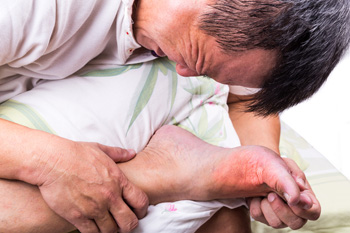
Do you have pain in your big toe? Is your big toe swollen? Did these symptoms occur after being sick or becoming injured? If you answered yes to any of these questions, you may be afflicted with a condition known as gout. Gout is an inflammatory type of arthritis caused by a buildup of uric acid in the blood. Uric acid is naturally produced in the body to help you break down foods that contain purines. Once the purines are broken down, they are cleansed from the body through urine. If something interferes with this process, the buildup of uric acid can turn into urate crystals that collect around soft tissues and joints like the big toe. This can result in inflammation or gout. Men are said to be more susceptible to gout, as are those who eat foods rich in purines. Genetics, health problems like diabetes or high cholesterol, being obese, those who drink alcohol, and those who take diuretics may have an increased risk of developing gout. The pain from gout can be so severe it can interfere with walking and other daily activities. If you think you have gout, make an appointment to see a podiatrist for an accurate diagnosis and a treatment plan.
Gout is a foot condition that requires certain treatment and care. If you are seeking treatment, contact Scott Matthews, DPM, MD from Salem Foot Care . Our doctor will treat your foot and ankle needs.
What Is Gout?
Gout is a type of arthritis caused by a buildup of uric acid in the bloodstream. It often develops in the foot, especially the big toe area, although it can manifest in other parts of the body as well. Gout can make walking and standing very painful and is especially common in diabetics and the obese.
People typically get gout because of a poor diet. Genetic predisposition is also a factor. The children of parents who have had gout frequently have a chance of developing it themselves.
Gout can easily be identified by redness and inflammation of the big toe and the surrounding areas of the foot. Other symptoms include extreme fatigue, joint pain, and running high fevers. Sometimes corticosteroid drugs can be prescribed to treat gout, but the best way to combat this disease is to get more exercise and eat a better diet.
If you have any questions please feel free to contact our office located in Wikesboro, NC . We offer the newest diagnostic and treatment technologies for all your foot and ankle needs.
Foot Structure and Skin May Change in Elderly Feet
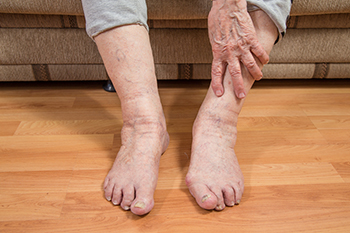 Many elderly people endure foot pain, which may impact mobility and completing daily activities. Research has shown there may be increased soft tissue stiffness in the foot, in addition to having a limited range of motion as one ages. With advanced age, the foot can lose overall strength and may become protonated as a result of reduced joint mobility. The risk of falling may increase, foot pain may develop, and it may be difficult to complete weight bearing activities. Approximately one in five people lose the ability to leave their house because of devastating foot pain. The skin may change thickness, and can add friction to the feet while walking. Recent reviews have confirmed the overall loss of elastin, which can result in thicker and dryer skin on the skin. In summation, the skin condition and foot structure may change in elderly feet, and may cause foot conditions that did not exist in their youth. If you would like more information about how the feet change as the aging process occurs, please consult with a podiatrist.
Many elderly people endure foot pain, which may impact mobility and completing daily activities. Research has shown there may be increased soft tissue stiffness in the foot, in addition to having a limited range of motion as one ages. With advanced age, the foot can lose overall strength and may become protonated as a result of reduced joint mobility. The risk of falling may increase, foot pain may develop, and it may be difficult to complete weight bearing activities. Approximately one in five people lose the ability to leave their house because of devastating foot pain. The skin may change thickness, and can add friction to the feet while walking. Recent reviews have confirmed the overall loss of elastin, which can result in thicker and dryer skin on the skin. In summation, the skin condition and foot structure may change in elderly feet, and may cause foot conditions that did not exist in their youth. If you would like more information about how the feet change as the aging process occurs, please consult with a podiatrist.
If you have any concerns about your feet, contact Scott Matthews, DPM, MD from Salem Foot Care . Our doctor can provide the care you need to keep you pain-free and on your feet.
Biomechanics in Podiatry
Podiatric biomechanics is a particular sector of specialty podiatry with licensed practitioners who are trained to diagnose and treat conditions affecting the foot, ankle and lower leg. Biomechanics deals with the forces that act against the body, causing an interference with the biological structures. It focuses on the movement of the ankle, the foot and the forces that interact with them.
A History of Biomechanics
- Biomechanics dates back to the BC era in Egypt where evidence of professional foot care has been recorded.
- In 1974, biomechanics gained a higher profile from the studies of Merton Root, who claimed that by changing or controlling the forces between the ankle and the foot, corrections or conditions could be implemented to gain strength and coordination in the area.
Modern technological improvements are based on past theories and therapeutic processes that provide a better understanding of podiatric concepts for biomechanics. Computers can provide accurate information about the forces and patterns of the feet and lower legs.
Understanding biomechanics of the feet can help improve and eliminate pain, stopping further stress to the foot.
If you have any questions please feel free to contact our office located in Wikesboro, NC . We offer the newest diagnostic and treatment technologies for all your foot and ankle needs.
Children, Physical Activity, and Sever’s Disease
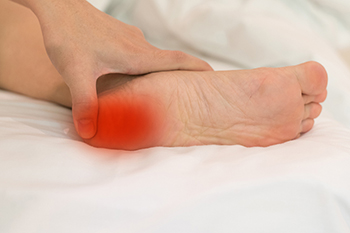
The heel condition that is referred to as Sever’s disease generally affects children and young teenagers who are involved in sporting activities. The heel can often feel sore when Sever’s disease is present, and it may be difficult to walk. It is defined as a condition that affects the growth plate in the heel, and can be confirmed by having a physical examination performed. Relief is often found when the activity that caused the condition is stopped, and the heel is frequently rested. It is important to practice specific stretches once the heel feels better, and this may help to accelerate the recovery process. Many patients choose to wear a heel cushion in their shoe which may be able to provide additional padding. If your child is affected by Sever’s disease, it is advised that a podiatrist be consulted for proper prevention and healing tips.
Sever's disease often occurs in children and teens. If your child is experiencing foot or ankle pain, see Scott Matthews, DPM, MD from Salem Foot Care . Our doctor can treat your child’s foot and ankle needs.
Sever’s Disease
Sever’s disease is also known as calcaneal apophysitis, which is a medical condition that causes heel pain I none or both feet. The disease is known to affect children between the ages of 8 and 14.
Sever’s disease occurs when part of the child’s heel known as the growth plate (calcaneal epiphysis) is attached to the Achilles tendon. This area can suffer injury when the muscles and tendons of the growing foot do not keep pace with bone growth. Therefore, the constant pain which one experiences at the back of the heel will make the child unable to put any weight on the heel. The child is then forced to walk on their toes.
Symptoms
Acute pain – Pain associated with Sever’s disease is usually felt in the heel when the child engages in physical activity such as walking, jumping and or running.
Highly active – Children who are very active are among the most susceptible in experiencing Sever’s disease, because of the stress and tension placed on their feet.
If you have any questions, please feel free to contact our office located in Wikesboro, NC . We offer the newest diagnostic and treatment technologies for all your foot and ankle injuries.
Skin Discoloration and Blisters May Indicate Diabetes
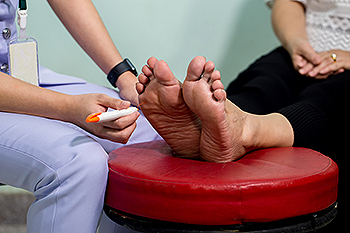 Diabetes is a serious illness that is caused by elevated glucose levels. It is common for diabetic patients to have foot problems, and severe infections can sometimes lead to amputation. Some of the symptoms that diabetics can feel are a numbing and tingling sensation, skin discoloration, and blisters may develop. Diabetic foot care consists of checking the feet daily for any cuts or bruises. This can be done by using a mirror to check the bottom of the feet. Additionally, it is important to control blood sugar levels, and this may be accomplished by eating foods that are healthy. Many patients find that implementing a gentle exercise program can help bring temporary relief from circulation issues that may accompany diabetes. If you are diabetic, it is strongly suggested that you are under the regular care of a podiatrist who can help you to manage this condition.
Diabetes is a serious illness that is caused by elevated glucose levels. It is common for diabetic patients to have foot problems, and severe infections can sometimes lead to amputation. Some of the symptoms that diabetics can feel are a numbing and tingling sensation, skin discoloration, and blisters may develop. Diabetic foot care consists of checking the feet daily for any cuts or bruises. This can be done by using a mirror to check the bottom of the feet. Additionally, it is important to control blood sugar levels, and this may be accomplished by eating foods that are healthy. Many patients find that implementing a gentle exercise program can help bring temporary relief from circulation issues that may accompany diabetes. If you are diabetic, it is strongly suggested that you are under the regular care of a podiatrist who can help you to manage this condition.
Diabetic foot care is important in preventing foot ailments such as ulcers. If you are suffering from diabetes or have any other concerns about your feet, contact Scott Matthews, DPM, MD from Salem Foot Care . Our doctor can provide the care you need to keep you pain-free and on your feet.
Diabetic Foot Care
Diabetes affects millions of people every year. The condition can damage blood vessels in many parts of the body, especially the feet. Because of this, taking care of your feet is essential if you have diabetes, and having a podiatrist help monitor your foot health is highly recommended.
The Importance of Caring for Your Feet
- Routinely inspect your feet for bruises or sores.
- Wear socks that fit your feet comfortably.
- Wear comfortable shoes that provide adequate support.
Patients with diabetes should have their doctor monitor their blood levels, as blood sugar levels play such a huge role in diabetic care. Monitoring these levels on a regular basis is highly advised.
It is always best to inform your healthcare professional of any concerns you may have regarding your feet, especially for diabetic patients. Early treatment and routine foot examinations are keys to maintaining proper health, especially because severe complications can arise if proper treatment is not applied.
If you have any questions please feel free to contact our office located in Wikesboro, NC . We offer the newest diagnostic and treatment technologies for all your foot and ankle needs.
